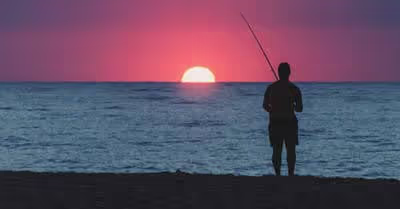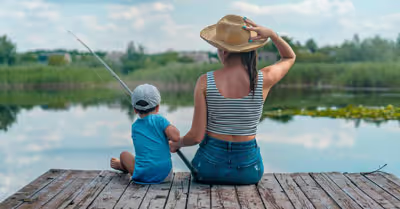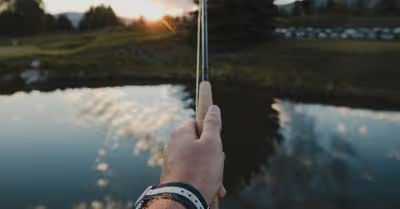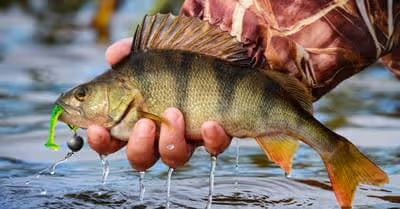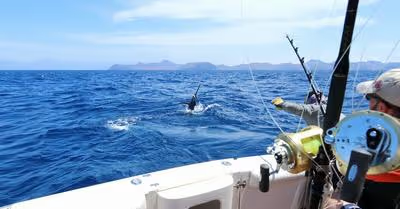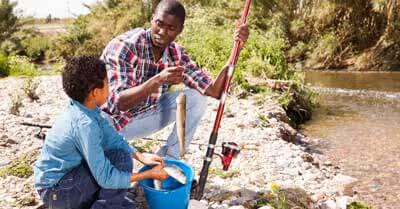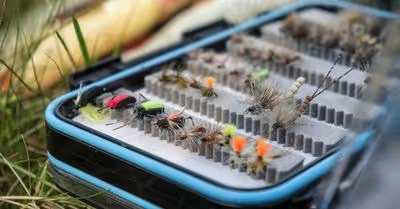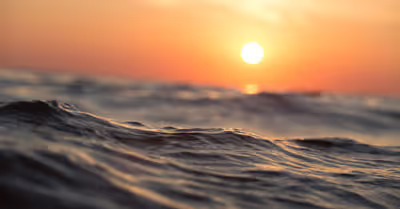Table of Contents
Fishing Basics
As a beginner, the most important thing when it comes to learning how to catch fish is learning the fundamentals of fishing, getting the required gear and license, going out on the water and applying what you’ve learned. An enjoyable activity for people of all ages and social classes, fishing can be a superb activity for the entire family. Additionally, fishing equipment and tackles are generally inexpensive. More importantly, you can be ready to reel in a fish if you learn the basic process of baiting a hook and casting the line.
That being said, fishing is essentially a fun activity that revolves around presenting bait, live or artificial, to fish with the main intention of tempting the fish to take the bait. The bait is set on the hook and if the fish takes a bite, it will be hooked and you’ll have to reel it out of water.
Reasons to Take up Fishing
While many people undertake fishing as a fun way of putting a meal on the table, others simply get involved in it as a hobby. Nonetheless, here are some reasons why fishing is so popular.
It’s a perfect way to relieve stress – Life and the daily hassles that come with it can be quite hectic. Fishing allows you to get away from it, recharge, and enjoy the beautiful nature in the company of friends and family or even strangers.
It’s a great way to socialize and bond – You’ll rarely find yourself lonely out there on the water. Anglers love to socialize and it can be a good way to make a few new friends. It’s also a perfect way to reconnect and strengthen the bond between friends and families.
It’s good for your physical and mental health – Fishing is a nice way to relax in the outdoor, which is, of course, good for both your physical and mental well-being.
It is fun – We all love fun, don’t we? Fishing is a joyous way to kick back, enjoy, and have a good time.
Anyone can get involved – Fishing is a perfect hobby for people of all ages and gender. It doesn’t matter whether you’re male, female, young, middle-aged or old, fishing will be a fantastic way to spend your free time.
Types of Fishing
It wouldn’t make any sense to spend this entire time talking about how to catch a fish without mentioning the types of fishing techniques. This is an important step in the sense that you get to know what to expect in various situations.
Freshwater Fishing
Whether it’s a pond just within your backyard, a stream, a river or a lake, you can’t lack a freshwater location in your area. Freshwater fishing is a great place to fish as a beginner as it requires little and inexpensive fishing equipment. Again, the fact that nearly 40% of fish species are found in freshwater bodies gives you a perfect chance to target some crappies, catfish, bass, walleye, trout and many more.
Saltwater Fishing
Saltwater fishing can also be a marvelous option for first-time anglers. The type of equipment that you use in saltwater fishing may, however, depend on the type of fish you’re targeting. So before venturing out, it’s best to choose the perfect gear for saltwater fishing.
Fly Fishing
While this type of fishing can be done in both saltwater and freshwater, it can be intimidating if you do not have a perfect fly rod, reel, and artificial flies. For this reason, you may put this technique on hold until you perfect your fishing skills before picking it up.
Shore Fishing
This revolves around catching fish from practically any freshwater or saltwater shore.
Kayak Fishing
Kayaks are very easy to navigate so it can be a great way if you want to spend some time on the water while catching fish. Here’s how to fish from a kayak.
Ice Fishing
If you love going outdoor at the height of the winter season, ice fishing can be suitable for you. In addition to some special fishing equipment such as ice auger to drill holes in the frozen waters, the ice must be thick enough to walk on.
Stand Up Paddle Board Fishing
This can be a great way to challenge yourself to an incredible full-body workout while catching some fish.
Catch and Release
If you’re not planning to take catch fish for a meal, you may opt to catch and release fish. This method requires extra caution and here’s how to catch and release.
Fishing Essentials: The Basics
Whether you’re planning to fish in freshwater, saltwater from land or deep in the sea, fishing is an inexpensive hobby that doesn’t require breaking the bank. But to get on the water and stand a chance of making some catch, there are various fishing gears that you must have. Keep in mind that fishing equipment can vary from very affordable to very expensive, so it’s often advisable that you go for something that’s within your budget.
Fishing Rods
Fishing rods generally vary in length, type of action, and the power that they have. In terms of length, you can choose a rod that ranges between 5 and 15 feet. Power is all about the amount of force or pressure it takes to bend the rod while action simply refers to how the rod flexes.
These features are an integral part of a fishing rod in terms of sensitivity and the ability to better handle large and powerful fish. They usually range from ultra-light to heavy and this can depend on the size and type of fish the rod is built for.
Here are some of the best fishing rods.
For beginners, you can choose St. Croix Triumph or Shakespeare Ugly Stix GX2.
Here’s how to choose a fishing rod.
Fishing Reels
Unlike in the good old days, modern fishing requires you to have a proper reel that will help you to cast your bait, retrieve your line, and land fish. Let’s highlight some types of reels that are suitable for any beginner.
Spinning Reel (Open Face)
This reel uses a simple flip bail to release the line from the spool. You can close the bail after casting your line, which then locks the line until when you want to retrieve it. Such types of reels are best if you’re looking for more casting distance but they require you to do a lot more practice than say a spincast reel. Here are the best spinning reels in the market.
Spincast Reel (Closed Face)
Spincast reels are the best reel for beginners as they are easy to use. This is because they rarely have tangles and come with button release systems that are ultimately easy to use. On the contrary, their retrieval systems are generally slow and may not be the best option when fighting a big and aggressive fish. This guide can help you choose the best fishing reel.
Baitcasting Reels
These types of reels are quite challenging and not ideal for beginners. They can, however, be superb if you’ve perfectly mastered the art of fishing and that’s essentially why they’re popular with experienced bass anglers. For now, check the difference between a spinning reel and a baitcasting reel and see what can work best for you.
Fishing Line
Needless to say, having a fishing rod and a reel won’t be of any help if you do not have an appropriate fishing line. This is because a fishing line is fundamentally what connects you with the fish.
When choosing the best fishing line, it’s always recommended that you have a rough clue of the type of fish you’re targeting. This is essential in helping you choose the appropriate pound test. This is the amount of pressure that the line can endure and a line with a test pound ranging from 10 to 15 should be perfect in handling most types of fish without sacrificing the much-needed line sensitivity.
Here are the main types of fishing line.
Monofilament
Made from a single strand, this fishing line is the best choice for beginner anglers as it’s quite affordable and very forgiving. Again, monofilament is very elastic and will easily stretch so it’s less likely to break even if you have a snag. As a beginner, it’s advisable that you stick to monofilament lines as they’re affordable, forgiving, and durable.
Fluorocarbon
Usually used as a leader. This essentially means that a small part of the line (some few feet) is attached and used together with another type of line. Nonetheless, a fluorocarbon line is perfect for fishing in clear waters. This is because it’s generally invisible to the fish and very sensitive, especially when you have a bite. Keep in mind that it’s expensive and quite difficult to manage, especially for beginners.
Braided Line
These are made from several strands to make it super strong. In addition to being highly sensitive, a braided line is very durable and will not easily break. It’s perfect if you’re planning to fish in an area with lots of submerged structures and weeds. This type of line is, however, very visible and can spook fish. Here are some of the best fishing lines.
Fishing Hooks
This is where you pin the lure and wait for the fish to bite so that it can get hooked. There are various types and sizes of hooks and the appropriate one will depend on the type of fish you’re planning to catch. It’s important to choose a small hook if you’re targeting smaller fish species such as crappies. On the contrary, a bigger hook should be perfect for a bigger fish species such as largemouth bass and bluegill. Here’s how to set the hook when fishing.
Baits and Lures
These are what you pin to the hook to lure the fish onto the hook. Natural baits are very popular thanks to their efficiency. They’re the real deal in the sense that they exactly look like the prey that the fish eat in their natural habitat. Some of the best natural baits include shrimps, crabs, crickets, worms, and minnows. Make sure that the natural bait that you choose is similar to what your targeted fish eat in its natural habitat.
When it comes to lures, there are several artificial lures that you can use for fishing. Most of them are designed to imitate the food that the fish normally eat. They’re also very versatile as they can be used at different depths. Although it’s important to understand the numerous lure options, here are some great options. This guide also offers you how to fish with lures.
Tackle Box
Whether you’re a beginner or an experienced angler, a tackle box plays an important role in every fishing trip. It is where you keep all your lures, hooks, lines, sinkers, bobbers, and everything else you need for an exciting fishing trip. In short, it’s important to have a storage system for your fishing trip and this is exactly what the tackle box is meant for.
How to Start Fishing
You now have all the necessary gear in place and you’re almost there.
Get a License
Before you set out for a fishing trip, it’s important that you get a fishing license for the area that you plan to fish at. Licenses are generally offered at the state level and are usually sold at fishing tackle shops or online. They’re relatively inexpensive and will cost not more than $150 per year, though the price will vary from state to state and may also depend on other factors such as residency and non-residency. You should also get specialized stamps if you’re going to fish for some unique fish species.
In addition to the license, keep in mind that there are various fishing regulations that you must adhere to. They include:
- Catch limit
- Tackle restrictions
- Seasons
Where to Go Fishing
With your gear and license all in place, it’s time to find a water body that holds fish. Whether it’s a lake a pond or a river, there are a lot of water bodies that are easily accessible to the public in the US. If you have to go to a water body that is privately owned, it’s only sensible to seek permission from the owner of the land. Nonetheless, a nearby lake can be a great option to learn how to catch a fish given that lakes generally have large volumes of different hungry fish species.
When To Fish
These generally depend on when the fish are most likely to bite. Fish are usually active when the water temperature is low. During the hot season, the best time to go fishing is very early in the morning or in the evening. You can avoid fishing when the sun is hot as fish tend to be lethargic and may not take a bite. If you have to fish when it’s hot, consider targeting deeper ends of the water body. You can, however, fish through all hours of the day during the cold season.
Learn How to Tie the Knots
Whether it’s about attaching the leaders to the mainline, tying the line to the rod or tying the hook to the line, knots play a central role in this process. And because there are several types of knots, it’s critical to learn how to tie different types of knots depending on your situation and what type of fish you’re targeting. Here are some of the most common types of knots and how to tie them.
The Types of Fish to Target as a Beginner
You’re probably wondering about the type of fish to target as a beginner. Although you can handle most fish species as a beginner, there are various less technical fish species that won’t make your first fishing technique difficult. They include:
- Catfish
- Panfish
- Trout
- Bass
No matter where you’re planning to fish, most water bodies in the United States have a lot of fish species that you can target as a beginner. So it is important to pick the brains of these fish species so that it becomes a lot easier to lure them to take a bite once you’re out there on the water.
Where to Find Fish
It’s important to always remember that fish generally like to hide in both natural and artificial structures found in the water. So when out on the water, especially on a lake, you should target below overhanging trees, beneath drowned logs, next to wrecks, steep drop-offs, boulder formations, weed beds, below piers and many other structures in the water.
If you’re fishing in a river, you can target areas that break or slow down fast-moving currents such as boulder formations or areas with slow currents, as well as deeper pools. In essence, it’s of great importance that you read the water, weather, and temperature and how these factors can affect fishing.
The Best Types of Lures
When it comes to baits and lures, there’s nothing like the best. While natural baits are a great option if used appropriately, you can choose artificial lures that mimic the prey of your targeted fish. For this reason, you should have a lot of lures in your tackle box and try out several to find what the fish prefer at a particular time.
How to Catch Your First Fish
The most important steps in fishing are casting, hooking, and landing fish. Without this, your first catch may be quite elusive.
Casting
Casting your line should not be an intimidating process. Spin the reel intuitively and chuck the lure as far as you can. You can start at about six inches from your standing point. Make sure that the reel is in your dominant hand and keep the line from tangling or spooling.
Flip the bail on the reel, hold the line with your finger, and bring the tip of the rod up and slightly behind you by casting forward using your wrist and elbow. Release the line when it’s vertically above your head and send the lure flying to where you want to cast at. Once the lure is settled in the water, you can sit back and wait for the fish to bite. It may, of course, require you to be very patient.
Hooking
When the fish takes a bite, it’s important to remain calm and patient so that the fish doesn’t spit the lure or to break the line trying to escape. If you feel a bite on your line, take around two seconds to let the fish to fully bite. This is to let the hook perfectly set in the fish’s mouth.
Once the hook is properly set, play the fish until it tires out. This requires you to keep the tip of the rod up while ensuring that the line doesn’t break under the weight and power of the fish, especially if it’s aggressive. Just remain patient and let the fish tire out and reeling it will be super easy.
Landing
The fish is now hooked and probably very tired after trying to fight you. At this point, you can slowly reel in the fish and scoop it up when it’s at an arm’s length. Do not touch the fish with your bare hand or squeeze it if you want to release it back into the water. Differently, having your first catch should be thrilling and memorable.
Final Verdict
Learning how to catch fish is as simple as A, B, C, but the actual process can be quite intimidating if you’re new to this thrilling hobby. However, it’s a rewarding experience and should be a lot easier with continuous practice. With time, you’ll master the art of fishing and become an expert at it. Remember, persistence is key.
Do not forget to invest in fishing gear, a license, and do some research on how to catch fish. More importantly, make sure that you learn and constantly improve. Hopefully, you’ll enjoy the thrills and adrenaline that comes with getting a bite on your line.
Tight lines, pals!
Recent Articles



